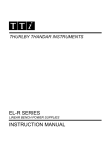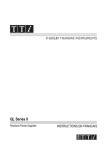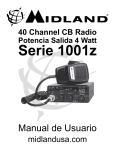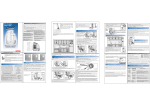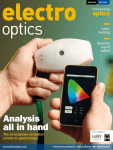Download Electrically focus tunable lens EL-10-30
Transcript
Operating instructions: EL-10-30-Series Electrically focus tunable lens Document number: 131-198-00 Date: 21.03.2014 Copyright © 2014 Optotune Electrically focus tunable lens EL-10-30-Series Operating instructions Safety warnings Read these operating instructions carefully before using the product. It will help you operate the product optimally, increase its lifetime and avoid problems and damage. x Follow all safety instructions, including the instructions of any attached equipment x No safety switch: Not adhering to the maximal electrical values can lead to malfunctions or even damage the lens! x Fire hazard: The lens can become very hot if operated at high currents x Danger of leakage: A non-toxic fluid may leak if the lens is damaged x This product is to be operated by qualified personnel only These operating instructions are part of the product and are to be within reach at all times. Should the product be re-sold or passed on to a third party, then these instructions must be passed on together with the product. Page 1 of 6 No representation or warranty, either expressed or implied, is made W W W.as S TtoEthe Mreliability, M E R- I completeness M A G I N Gor . Caccuracy O M of this paper. Optotune AG | Bernstrasse 388 | CH-8953 Dietikon | Switzerland Phone +41 58 856 3000 | www.optotune.com | [email protected] Operating instructions: EL-10-30-Series Electrically focus tunable lens Document number: 131-198-00 Date: 21.03.2014 Copyright © 2014 Optotune Technical data Operating voltage: Internal resistance at room temperature: Operating current (typical): Absolute maximum current: Maximal recommended power input: Inductance of the motor: 0-5 VDC 12.5 Ohm 0-300 mA 400 mA 1.1 W (300 mA) in continuous operation 2.0 W (400 mA) short term (<1 minute) 10 Hz: 3.5 mH 1 kHz: 0.8 mH 50 Hz: 2.9 mH 10 kHz: 0.6 mH 100 Hz: 2.5 mH 100 kHz: 0.4 mH Connecting the lens All EL-10-30-Series lenses have an electro-magnetic motor, which is driven by current. The lens will only work with the correct polarity of the current. False polarity will not damage the lens. EL-10-30 (compact version) The EL-10-30 has a simple copper cable connection. The correct polarity is shown in Figure 1: + Copper cable – Figure 1: Connection of the EL-10-30. The colored cable is the positive terminal and the copper cable is the negative terminal. EL-10-30-C (C-mount version) The EL-10-30-C has an FPC connection compatible with Molex 0.5mm pitch 6 way FPC backflip connector (P/N 503480-0600). An adaptor board with integrated connector is included for easy soldering. The connector on the adaptor board has top and bottom contacts so it is important that once orientation is established it must be maintained. The EL-10-30-C also features an integrated NXP SE97B temperature sensor with 256 bytes of memory – the sensor is addressable via the pins as detailed below (I2C address is 0011000RW): Pinning Pin 1 Position Function SE97B Pins 1 SE97B Gnd 1-4 2 Lens (- pole) - 3 Lens (+ pole) - 4 SE97B SDA 5 5 SE97B SCL 6 6 SE97B Power 8 Figure 2: Connection of the EL-10-30-C (Orientation looking at exposed Cu tracks) Page 2 of 6 No representation or warranty, either expressed or implied, is made W W W.as S TtoEthe Mreliability, M E R- I completeness M A G I N Gor . Caccuracy O M of this paper. Optotune AG | Bernstrasse 388 | CH-8953 Dietikon | Switzerland Phone +41 58 856 3000 | www.optotune.com | [email protected] Operating instructions: EL-10-30-Series Electrically focus tunable lens Document number: 131-198-00 Date: 21.03.2014 Copyright © 2014 Optotune EL-10-30-Ci (industrial version) For the industrial version EL-10-30-Ci the connection with the 6-pin Hirose connector is straight forward. Pinning Position Function SE97B Pins 1 SE97B SDA 5 2 SE97B SCL 6 3 SE97B Power 8 4 SE97B Gnd 1-4 5 Lens (- pole) - 6 Lens (+ pole) - Operating the lens with a standard power supply Several standard power supplies can be used as a current source. The internal resistance of the lens is of 12.5 Ohm at room temperature. Following Ohm’s law: U = R x I, 400 mA can be driven through the lens with a 5 V supply voltage. This maximal value should not be exceeded. The recommended handling procedure of the lens is as follows: 1. 2. 3. 4. Set the supply voltage to 5 V Switch over to current control Connect the lens Adjust the driving current with current control knob Switch between voltage and current control Voltage control Current Control Figure 1: Use of a standard power supply to drive the EL-10-30. Left: Voltage display in volts. Right: Current display in milliamps. The power consumption of the lens, derived from P = R x I2, is of 2 Watts at maximum. This consumption is dissipated in heat. The lens may become very hot if it is operated over a long period of time with more than 1.1 Watt power consumption (300 mA in terms of current). Attention: Using a current over 400 mA for several minutes may thermally damage the lens! Page 3 of 6 No representation or warranty, either expressed or implied, is made W W W.as S TtoEthe Mreliability, M E R- I completeness M A G I N Gor . Caccuracy O M of this paper. Optotune AG | Bernstrasse 388 | CH-8953 Dietikon | Switzerland Phone +41 58 856 3000 | www.optotune.com | [email protected] Operating instructions: EL-10-30-Series Electrically focus tunable lens Document number: 131-198-00 Date: 21.03.2014 Copyright © 2014 Optotune Recommended drivers/power supplies Optotune provides its own high-precision USB driver with a resolution of 0.1mA. It includes the I2C readout of the temperature sensor, which can be used for temperature compensation. There are also many alternative off-the-shelf products available that can be used to control the EL-10-30: x x x x x Precision constant current driver for laser diodes with external control via 0-5V analog signal (e.g. Edmund Optics NT56-804 or NT84-355) For high precision applications (0.1mA resolution) with manual control: TTi QL355 For high precision applications (0.1mA resolution) with USB/RS232 computer control: TTi QL355P For low precision applications (1mA resolution) with manual control: TTi EL301R For low precision applications (1mA resolution) with USB computer control: Quakko HY3005DP http://shop.vendio.com/Evan2002/item/2041700966/?s=1282809362 Operating the lens with custom electronics Dedicated control electronics can be designed e.g. by using pulse width modulation (PWM). The frequency in this case should be set between 20 kHz and 50 kHz. Another very useful component is the ADN8810 programmable precision current source of Analog Devices, which features 12 bits of resolution and can be controlled with an SPI interface. If the lens is operated with custom-built or non-certified electronics, Optotune cannot guarantee the correct functioning of the lens and is not liable for any consequences of its use. Mounting possibilities The EL-10-30-C is compatible with C-Mount lens fixtures. Alternative mounting options include: G024503000, LINOS http://www.qioptiqshop.com/ G061042000, LINOS http://www.qioptiqshop.com/ KM200V/M, Thorlabs http://www.thorlabs.de/ NT03-676, Edmund Optics http://www.edmundoptics.com/ Exchanging the offset lens in the EL-10-30-C The EL-10-30-C is shipped with a planar cover glass or with an integrated offset lens (MV version), which is held in place by a retainer ring. The cover glass or offset lens can easily be exchanged by hand following the procedure outlined below. Please note that this is preferably done in a clean room or under a flow hood to avoid dust entering the tunable lens. 1. 2. 3. 4. 5. 6. Loosen the retainer ring carefully with a small screw driver After about 5 rotations turn the lens with the ring pointing down so no dust can get into the lens Take out the cover glass / offset lens with the retainer ring. Prepare the new cover glass or lens. Turn the lens again, but be careful, that no dust gets inside. Carefully drop the new cover glass or lens (planar side should usually look down towards the lens) inside using tweezers. Put the retainer ring in by hand Tighten the retainer ring with a screw driver. Be careful not to scratch the glass. IMPORTANT: At the end, do not exert much torque (<1 Nm) as this might damage the tunable lens. Page 4 of 6 No representation or warranty, either expressed or implied, is made W W W.as S TtoEthe Mreliability, M E R- I completeness M A G I N Gor . Caccuracy O M of this paper. Optotune AG | Bernstrasse 388 | CH-8953 Dietikon | Switzerland Phone +41 58 856 3000 | www.optotune.com | [email protected] Operating instructions: EL-10-30-Series Electrically focus tunable lens Document number: 131-198-00 Date: 21.03.2014 Copyright © 2014 Optotune 1 4 2 3 5 6 Page 5 of 6 No representation or warranty, either expressed or implied, is made W W W.as S TtoEthe Mreliability, M E R- I completeness M A G I N Gor . Caccuracy O M of this paper. Optotune AG | Bernstrasse 388 | CH-8953 Dietikon | Switzerland Phone +41 58 856 3000 | www.optotune.com | [email protected] Operating instructions: EL-10-30-Series Electrically focus tunable lens Document number: 131-198-00 Date: 21.03.2014 Copyright © 2014 Optotune Trouble shooting The lens does not work (focal point does not move at all) 1. Check if pins 2 and 3 (for EL-10-30-C) or cables (for EL-10-30) are correctly connected (note that the cable of the EL-10-30 is only conductive at the cable tips, which are covered in solder) Try switching the polarization (connect cables/pins the other way round) Check if current is flowing using an ammeter or the current display of the power source Check the impedance of the lens, which should be 12.5 Ohm at room temperature If you cannot measure the right impedance or any current flowing at all, then an internal connection is damaged and the lens must be replaced. 2. 3. 4. 5. The focal point moves, but not as expected Try switching the polarization Measure the focal length and the current that flows through the lens with an ammeter at different levels. The back focal distance (measured from the back side of the lens housing) should follow a curve similar to the one depicted in Figure 3. The focal length should decrease monotonously with increasing current. If this is not the case, then there is an issue with the electro-magnetic motor and the lens must be replaced. Back focal length [mm] 3. 220 210 200 190 180 170 160 150 140 130 120 110 100 90 80 70 60 50 40 30 20 10 0 EL-10-30-C with LD liquid EL-10-30 LD material EL-10-30 HR material 0 25 50 75 100 125 150 175 Current [mA] 200 225 250 275 300 Figure 3: Typical relation of focal length to current of different EL-10-30 configurations Page 6 of 6 STEMMER IMAGI NG Head Office Imaging is our passion. No representation or warranty, either expressed or implied, is9made Gutenbergstraße - 13, D-82178 Puchheim Optotune AG | Bernstrasse 388 | CH-8953 Dietikon | Switzerland W W W.as S TtoEthe Mreliability, M E R- I completeness M A G I N Gor . Caccuracy O MPhone: Phone +41 58 856 3000 | www.optotune.com | [email protected] of this paper. +49 89 80902-0, [email protected] www.stemmer-imaging.com O-OPTU4-06/2015 ∙ Subject to technical change without notice. No liability is accepted for errors which may be contained in this document. 1. 2.









